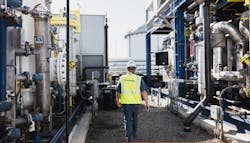Michigan PSC grants $5M to Anaergia Bioenergy Landfill-to-Energy site
Anaergia's subsidiary Kent County Bioenergy Facility has received a $5 million grant from the Michigan Public Service Commission to develop the Kent County Bioenergy Facility, which is a project worth $380 million in partnership with the Kent County Department of Public Works (DPW).
The Kent County Bioenergy Facility, planned as the anchor tenant at the Sustainable Business Park, is designed to increase recycling, reduce Kent County’s dependence on landfills, create jobs, reduce greenhouse gas emissions, and produce carbon-negative renewable fuel.
The Kent County DPW will seek an approval from the Kent County Board of Public Works to proceed with the project in July. Post approval from the Kent County Board of Commissioners, the project is expected to be fully operational by early 2027.
“Kent County has a real opportunity to create a better world for future generations by building the Kent County Bioenergy Facility and Sustainable Business Park,” said Dar Baas, director at the Kent County Department of Public Works.
More on Biofuels in the C&I Energy Transition covered by EnergyTech
Divert building Food Waste-to-Energy plant in California
Northern Biogas acquires three new Dairy RNG projects in eastern U.S.
Read our latest ET Newsletter: Solar in the Heart of the Oil Sands and more
Designed to help Kent County divert 90 percent of trash from the local landfill by 2030, the facility anticipates to transfer 50 percent of municipal solid waste, initially. The process will help reduce methane emissions, while recovering organic material in the waste and converting it into renewable natural gas and fertilizer.
“Over 40% of what is landfilled in the U.S. creates methane, a potent greenhouse gas that is responsible for at least 30% of global warming to date—so projects like the one being developed by Kent County Bioenergy Facility will do no less than help save the planet,” said Brett Hodson, CEO of Anaergia.
Many environmental experts contend that methane is multiple times more harmful to the atmosphere than carbon dioxide.
Last month, Anaergia announced it will provide technologies that will enable Monterey One Water, the wastewater utility of northern Monterey County, California, to make renewable energy from food waste as well as wastewater. The project will significantly expand anaerobic digestion capacity at Monterey One Water’s Regional Treatment Plant (RTP) in Marina, according to reports.
This will allow the utility to receive and co-digest food waste in existing digesters currently used to process wastewater biosolids. When anaerobically digested, the waste produces renewable biogas, which is then used to generate electricity and heat at the Monterey One plant.
About the Author
EnergyTech Staff
Rod Walton is head of content for EnergyTech.com. He has spent 17 years covering the energy industry as a newspaper and trade journalist.
Walton formerly was energy writer and business editor at the Tulsa World. Later, he spent six years covering the electricity power sector for Pennwell and Clarion Events. He joined Endeavor and EnergyTech in November 2021.
He can be reached at [email protected].
EnergyTech is focused on the mission critical and large-scale energy users and their sustainability and resiliency goals. These include the commercial and industrial sectors, as well as the military, universities, data centers and microgrids.
Many large-scale energy users such as Fortune 500 companies, and mission-critical users such as military bases, universities, healthcare facilities, public safety and data centers, shifting their energy priorities to reach net-zero carbon goals within the coming decades. These include plans for renewable energy power purchase agreements, but also on-site resiliency projects such as microgrids, combined heat and power, rooftop solar, energy storage, digitalization and building efficiency upgrades.
